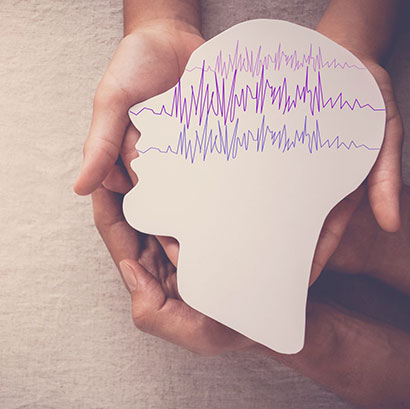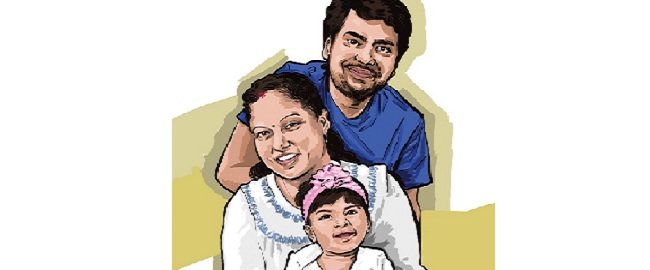3-Year-Old Ball Of Energy Now Seizure-Free

April 09, 2021
Typically, we photograph every patient appearing in HealthU. Because this story was planned during the COVID-19 pandemic, that contact would have been too risky. Instead, our team took a creative approach and replaced photo shoots with illustrated portraits of patients.
On January 3, 2018, Karen and John Ganley welcomed their third child to their family. After 18 hours of labor, an almost-10-pound Braydin was delivered via cesarean section, and for a little while, everyone seemed happy and healthy.
Because she had a C-section, Karen needed to stay in the hospital for a couple of days to recover from the surgery. “After being in labor so long, resting in a hospital bed and having people take care of me was just what I needed,” Karen says. “I was glad to stay.”
It’s a good thing she did, too. On Braydin’s third day of life, he started exhibiting some strange behavior.
“My husband was holding him and noticed that he was blinking in a weird way,” Karen says. “I thought he was just getting acclimated to the lights in the room and didn’t think much of it.”
John’s brother and sister-in-law soon arrived to meet their nephew, and not long into their visit, they also noticed Braydin’s rapid blinking and winking. Doctors quickly tended to Braydin and discovered that he was having as many as 20 seizures a day, each one lasting about 30 seconds. The family began learning the warning signs of an oncoming seizure, which included Braydin’s tiny body warming up and his breathing becoming labored.
“Watching this harmless baby have a seizure was horrible,” Karen says. “No parent should ever have to see that. You feel so helpless.”
When Less Is More
A few days later, after not being able to control his seizures, Braydin was transferred to another hospital for further evaluation. Doctors were able to control his seizures with medication, and he was sent home after two weeks. But his family still didn’t know what was causing these frightening episodes.
“Not having an answer was so hard,” Karen says. “There was absolutely nothing wrong with him otherwise.”
In April, Braydin had another seizure while at home. Karen repeatedly called the previous hospital they visited to get help and see if his medication needed to be altered, but she had trouble getting a response.
Instead of waiting, they packed baby Braydin into his car seat and drove him to the Pediatric Emergency Department at K. Hovnanian Children’s Hospital at Jersey Shore Medical Center. Later, they met with Richard Sultan, D.O., director of child neurology for inpatient services at the Children’s Hospital.
“When I met Braydin, he was on many different medications,” Dr. Sultan says. “So I just started from the beginning. I started over, and eventually, less [medication] was more beneficial to reducing the seizures.”
Answers at Long Last
While Dr. Sultan was working to control Braydin’s seizures with the right combination of medicines, his parents met with Reena Jethva, M.D., MBA, a pediatric geneticist at the Children’s Hospital, to test for any genetic abnormalities that may have caused the seizures.
Sure enough, Dr. Jethva confirmed a gene variant responsible for Braydin’s seizures. He had a rare condition called KCNQ2 Developmental and Epileptic Encephalopathy. Children with this disease typically experience multiple daily seizures that begin within the first week of life. Seizures often resolve themselves within months to a few years but can still cause delays in motor, social, language and cognitive development.
“Finding out about this diagnosis made the family aware that his seizures could be limited and he may not suffer from a long-term seizure disorder,” Dr. Jethva says. “I’m sure learning this brought them some relief.”
A week later, Braydin was sent home from the hospital. Dr. Sultan put Braydin on three different medications and told his parents exactly how and when to administer them.
In June 2018, Braydin had another seizure, but rather than rushing to the emergency room, Karen called Dr. Sultan, who advised her about what to do.
“As he gets bigger, we have to tweak his medications, so they stay at therapeutic levels,” Karen says. “Dr. Sultan always answers my calls and tells us how to get things under control.”
Growing and Thriving
Braydin had one more seizure in September 2018, but he has been seizure-free since then. Today, he is a happy, running, playing, babbling toddler, who absolutely loves his two older (and very protective) siblings, Madilyn, 8, and Griffin, 5.
“He’s just the best thing ever. He’s my little peanut,” Karen says. “He’s not your typical 3-year-old; he’s a little delayed. But we work every day to make him stronger, and he’s getting there.”
Dr. Sultan says Braydin’s speech is slightly delayed, but the rest of his development is age-appropriate.
“One of the best things in pediatric neurology is witnessing a child’s ability to recover,” Dr. Sultan says. “I’m cautiously optimistic that Braydin will go on to have a pretty normal life.”
These days, Dr. Sultan sees Braydin every four months for a checkup and has already eliminated one of his medications.
“Teams of doctors prior couldn’t accomplish what Dr. Sultan did,” John says. “We will forever be grateful to him.”
Next Steps & Resources:
- Learn how our pediatric neurology specialists work closely with families to manage their child’s neurological condition and improve quality of life
- Meet our sources: Reena Jethva, M.D., MBA and Richard Sultan, D.O.
- To make an appointment with Dr. Jethva, Dr. Sultan or another doctor near you, call 800-822-8905 or visit our website.
Signs your child is having a seizure
How to care for a child with a seizure disorder
The material provided through HealthU is intended to be used as general information only and should not replace the advice of your physician. Always consult your physician for individual care.
Find a doctor near me
Signs Your Child Is Having a Seizure

Recognize child seizure signs? Learn how to help from Dr. Tomycz, Joseph M. Sanzari Children's Hospital. Get expert advice now.
How to Care for a Child With a Seizure Disorder

Learn how to care for a child with a seizure disorder. Dr. Sultan offers expert advice on medication, seizure safety, and triggers. Help your child thrive.
Find a doctor near me
New Jersey Teen Back in Action After Concussion
New Jersey teen's concussion recovery. Dr. Greiss's expert care helped him return to football. Learn more about concussion treatment & recovery.

Jersey City Toddler Plagued by Seizures Is Now Seizure-free
Jersey City toddler's seizures stopped. Learn how doctors at Joseph M. Sanzari Children's Hospital helped Shanaya become seizure-free. Find hope & expert care.

My Story About Taking My Kids to the ER During COVID – Danielle
Danielle shares her positive ER experience during COVID. Learn how Sanzari Children's Hospital provided safe, smooth care for her kids. Call 800-822-8905 for care.

25-year-old Man on the Road to Recovery After a Debilitative Brain Injury
Brain injury recovery story: 25-year-old Michael's journey to regaining independence after a debilitating injury at Jersey Shore University Medical Center and JFK Johnson Rehabilitation Institute. Learn more.
